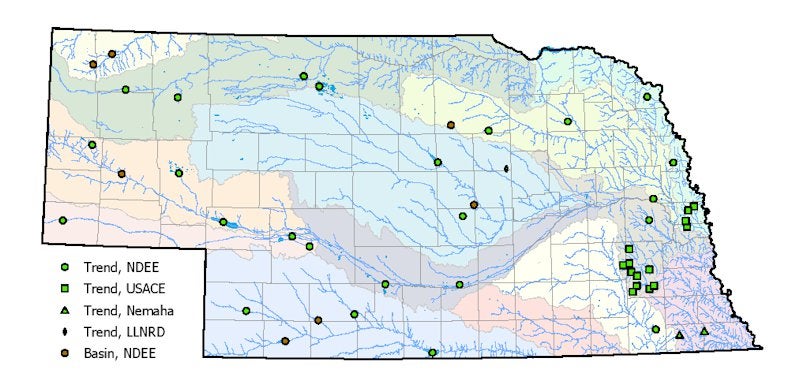Ambient Lake Monitoring Program
Why Monitor Lakes and Reservoirs?
Nebraska’s natural lakes and man-made reservoirs have different public usage throughout the year. DWEE monitors these resources to determine if water quality is sufficient for recreational activities such as swimming and water skiing, and suitable for fish and other aquatic organisms to survive and reproduce.
Monitoring involves the collection of monthly water samples from May through September from publicly owned lakes and reservoirs across the state. In some cases, the streams that flow into reservoirs are also monitored. Since reservoirs are a reflection of their watersheds, data on streams that flow into reservoirs can provide useful information in evaluating water quality problems.
Monitoring is done at 42 long term trend lakes across the state on a monthly basis by DWEE and its sampling partners, the US Army Corp of Engineers, Nemaha Natural Resources District, and Lower Loup Natural Resources District. In addition, monitoring is conducted on an additional 4 lakes on a biannual rotation. The map below shows the locations of the 42 long term trend lakes.

What is monitored?
To determine if water quality is sufficient to meet its intended uses in these lakes, samples are taken monthly near the surface at the deep water site (deepest area) of each lake. These sites are sampled for physical/chemical parameters such as water temperature, dissolved oxygen (DO), pH, conductivity, water clarity, total suspended solids, ammonia, nitrate-nitrite nitrogen, kjeldahl nitrogen, total and dissolved phosphorus, alkalinity, chlorophyll a, and select pesticides.
In addition, surface to bottom profiles are collected for temperature, DO, pH, and conductivity. Profile data is collected every 0.5 meters starting at the water surface and are used to determine at what depth lake stratification may take place. An additional profile is also collected at a location approximately in the middle of the lake and is considered a mid-lake site.
How are the Data Used?
Collected data are compared to a water quality standard or a benchmark that will indicate if there is a concern. For most parameters, a minimum number of violations or excursions will be allowed before the waterbody is considered to be impaired or not to have sufficient quality. If a waterbody is considered to be impaired, it will be placed on Nebraska’s Section 303(d) List of Impaired Waters. Once on this list, more information is collected to develop water quality targets and pollutant reduction goals. These targets and reductions are incorporated into a document called a Total Maximum Daily Load (TMDL). The TMDL then provides the basis for water quality improvement projects sponsored by various resource management and funding agencies such as Natural Resources Districts, municipalities, Nebraska Game and Parks Commission, and USDA-Natural Resources Conservation Service to name a few. While the Section 303(d) list is revised every two years, assessments on each lake or reservoir are conducted on an annual basis. Results of the assessments are presented in the Water Quality Integrated Report that is prepared by DWEE on even numbered years. The 2022 report is available on-line at: 2022 Nebraska Water Quality Integrated Report.
Statewide Concerns
Nutrients and algae related issues are the most common lake impairments. Excessive algae growth can increase the pH of the water which can make some things, like ammonia, more toxic to aquatic organisms. Excessive nutrients can also lead to blooms of blue-green algae and high concentrations of microcystin, which is a toxin produced by this algae.
The accumulation of contaminants in the tissue of fish is a growing concern across the country. Approximately 35 percent of the lakes assessed had unacceptable concentrations of contaminants in fish tissue (see “Fish Tissue Monitoring” section of this report). In most cases, the impairments were due to mercury which is believed to be entering lakes through atmospheric deposition.
Lake Improvement Programs
When water quality programs were first initiated at DWEE, most efforts were aimed at reducing the impacts of point source discharges. From the early 1970s through the present, lake and reservoir management has evolved to include nonpoint sources. Several programs administered by DWEE, as well as other local, state, and federal programs, work to protect impounded waters. Some of the programs administered by DWEE that are protective of the quality of impounded waters include Livestock Waste, Wastewater, Storm Water, and Nonpoint Source.
Numerous agencies, including local, state, and federal, are involved in different aspects of lake and reservoir management whether it be the collection and/or assessment of data, water quality planning, or implementing projects to address water quality problems. The coordination of efforts among these entities has allowed for a more comprehensive and cost effective approach to lake and reservoir management.
More Information
Contact program specialists by calling 402-471-4224 or 402-471-2810
